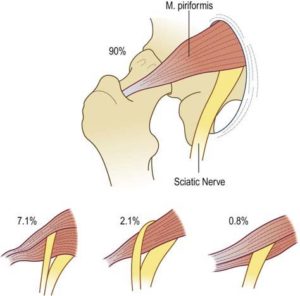What is Piriformis Syndrome?
What is Piriformis Syndrome?
Piriformis syndrome is a condition in which the piriformis muscle becomes tight and painful. Tension in this muscle can also cause compression and or irritation of the sciatic nerve, leading to symptoms of “sciatica” such as numbness, tingling or burning pain in the buttocks, thigh, or leg.
Anatomy:
The piriformis is a relatively short muscle, which attaches from the sacrum (the triangular bone at the base of your spine) into the greater trochanter of the femur (thigh bone). It is one of the deep external rotators of the hip and sits underneath the larger buttock muscle, the gluteus maximus. When you are standing with the hip neutral the piriformis rotates the hip outwards (external rotation), but when the hip is flexed to 90 degrees (as it typically is when you are sitting), the muscle rotates the hip inwards (internal rotation) due to the change in hip position.

The sciatic nerve travels from the spine, and exits the greater sciatic foramen in the pelvis to run along the bottom surface of the piriformis muscle. In af the population the sciatic nerve pierces the piriformis muscle, splits the piriformis muscle or both. This may predispose individuals to developing piriformis syndrome.

There are two types of piriformis syndrome – primary and secondary. Primary piriformis syndrome has an anatomic cause such as split piriformis muscle, or split sciatic nerve. Secondary piriformis occurs as a result of trauma, ischemia (lack of blood flow), and excessive tension in the muscle.
What causes Piriformis Syndrome?
Piriformis syndrome may occur without any obvious cause but may also be associated with the following:
-
Fall on buttock
-
Prolonged sitting
-
Excessive strain on the muscle
-
Pregnancy
Signs & Symptoms of Piriformis Syndrome:
-
History of trauma to the region.
-
Pain deep in the buttocks.
-
Difficulty walking.
-
Pain transitioning from sitting or squat position.
-
Acute pain with bending forwards or lifting.
-
Intolerance for sitting.
-
Pain with sitting, standing or lying longer than 15-20 minutes.
-
Pain with bowel movements.
-
Pain, numbness or tingling into the back of the thigh and or leg.
-
Associated numbness, tingling, burning into butt, hamstrings, calves or feet.
Treatment:
The focus of treatment is to address the impairments that lead to piriformis syndrome and restore function. Initial treatment will focus on reducing pain in the area through education, treatment and rehabilitation.
1. Education:
-
Avoid sitting as much as possible.
-
Place muscle in slacked position by externally rotating the hip.
-
Avoid aggravating activities, such as standing, lifting, bending.
-
Rest from aggravating activities such as running and sports.
2. Class IV Laser:
Laser can help to decrease pain and inflammation, and increase blood flow and energy for cellular healing.
3. Mobilization & Myofascial Release (ART/FR):
Gentle mobilization of the lumbar spine, pelvis and hips helps to reduce tension in the piriformis and surrounding musculature by restoring normal function and mobility of these areas. Myofascial release therapy can decrease muscle tension in the piriformis and surrounding muscles.
4. Manipulation:
The piriformis muscle attaches into the sacrum, and crosses the SI joint. The pirifiromis and surrounding deep hip muscles are also supplied by the spinal nerves which branch from the lower spine. In some cases irritation of the joints or tissues in the spine or pelvis may be the primary problem, which drives pain and tension into the hip muscles (including prifiormis) In these cases spinal manipulation can help to decrease pain and improve mobility in the spinal segments.

5. Exercises/Rehabilitation:
-
Gentle hip and spine range of motion exercises (acute phase)
-
Gentle isometric loading of the piriformis to decrease inflammation & to decrease tension (acute phase)
-
Stretch & strengthen piriformis and surrounding musculature (once acute phase has passed)
-
Core exercises
-
Lumbopelvic control exercises
-
Hip control exercises
Mountain Health & Performance is back open for non-urgent care as of May 19th 2020! We will be following COVID-19 guidelines in our clinic to ensure the safety of our therapists and patients. Please call 604-984-0014 to book or click on the "book an appointment" button to book online.



